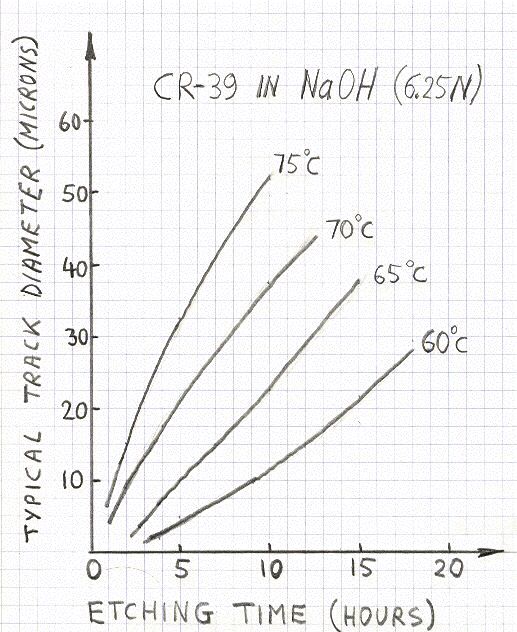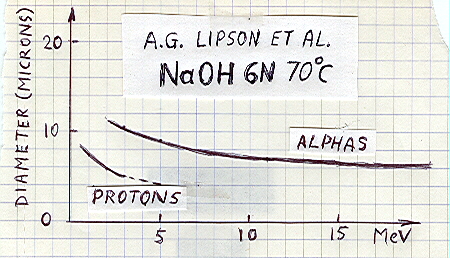After purchassin a large sheet of CR-39 from Fukuvi I conducted a little investigation. Using the 6.25 N solution of NaOH I decided to learn how the diameters of tracks depend on the etching time at four temperature, as illustrated below:

Return to the clickable list of items
185) About CR-39 Detectors
Ludwik Kowalski (November 14, 2004)
Department of Mathematical Sciences
Montclair State University, Upper Montclair, NJ, 07043
Several people asked me about using CR-39 detectors recently. Here are suppliers of that material that I know about. If you know another supplier then please send me the information about the firm and I will append it to the list below. My e-mail address is; <kowalskil@mail.montclair.edu>.
1) Landauer, Inc. (2 Science Road, Glenwood, IL 60425, USA)
Contact Rose Elza at radon Customer Service
Her phone # is 1-800-528-8327. Her e-mail address is: relza@landauerinc.com
One sheet (for uncut 350 pieces) costs $340. A set of 350 cut pieces (each piece has an engraved ID number) costs $560.
2) Alpha Trak Learning (141 Northridge Drive, Centralia, WA, 98531, USA)
Contact Criag Gabler <radon@alphatrak.com>. Minimum order, $100, covers 100 pieces; each piece is 1 cm by 1 cm.
3) Track Analysis System, Ltd. (H H Wills Physics Lab, Tyndal Avenue, Bristol, BS8 1TL, United Kingdom.)
Contact Peter Fews <Peter.Fews@bristol.ac.uk>
Minimum order for the USA is $500 (it is $100 in Europe). Various sizes (up to 27.5 cm by 28.0 cm) are available. For example, each piece of 2.5 cm by 2.5 cm (1 mm thick) costs $1.75.
4) Intercast Europe S.p.A. (P. Neri, Via Natta 10 / a 43100 Parma Italy
Tel +39 - 0521 - 607555 Fax +39 - 0521 - 607924)
p.neri@intercast.it www.intercast.it
The prices are, for example, 200 euros for the 40 by 70 cm sheet (thickness 0.7 mm) or 300 euros for the 96 by 96 cm sheet (thickness 1.4 mm).
5) Daedalon Corporation (Walter Brown, Daedalon Corporation, P.O. 2028, Salem, Ma, 01970-6228. Phone (978) 744-5310; FAX (978) 745-3065
daedalon@cove.com www.daedalon.com
Five round alpha particles films EN-21 (diameter 8.6 cm) costs $215.
They do not say it is CR-39. They wrote to me: “The film consists of a thin layer of cellulose nitrate coated on a poly ester base. If the film is struck be an alpha particle, it is structurally damaged so that the damaged spot can be etched away in a sodium hydroxide solution. The etched film has clear spots, where it has been struck, with a reddish background. The film has no sensitivity to other radiation.” [They probably mean beta and gamma rays. How can the material not be sensitive to particles produced by neutron radiation?]
6) American Acrylics and Plastics, 300 Benton Rd. PO Box 1045, Stanford Ct, 06497.
Tel: 203-377-0752
Dosimetry CR-39 plastic, $100 for one large sheet (looks like 1 by 1 meter).
7) Fukovi Chemical Industry, Japan.
This CR-39 material was calibrated by A. Lipson et al. (downloadable from the library at www.lenr-canr.org). The calibration consisted of measuring diameters of tracks for monoenergetic alpha particles and protons of various energies. It is valid for one set of specified etching conditions. Tracks due to protons are usually about two times smaller than for alpha particles of the same energy. I will assume that their calibration is applicable to CR-39 from other manufacurers, as the first approximation.
The CR-39 polycarbonate was patented (in 1939?) by an US company Columbia Research. This probably explains the name. Plastic lenses are now made from that material. Another use is detection of alpha particles, for example, from radon. Each particles creates a sub microscopic crater which can be enlarged by etching the plastic in the hot NaOH. After that the craters become observable through an ordinary microscope. Here is a brief description of the use of CR-39, as e-mailed to a friend about one month ago.
“ One simply peels off the protective thin plastic from the CR-39 and places the detector (about 1 mm thick) over an object that emits charged particles, such as alphas or protons. The material is not sensitive to electrons. The etching solution is NaOH in water (concentration 6.25 N). Make sure your skin does not come in contact with that solution; if it does then wash your hands at once for at least a minute or two. Preheat the NaOH solution to 65 C and suspend a detector in it for about 5 hrs. Then remove the CR-39 and wash it in water. The NaOH solution etches the surface slowly. At the same time it etches more rapidly along the invisible (latent) tracks of charged particles. That is how tracks become visible. If you etch too long, say 20 hrs, you might take away the layer that contains tracks. If you etch not long enough, say 1 hr, then tracks will be very small. The diameters of circles, due to alpha particles from Am-241, grow about linearly with the etching time (after the fist hour). I settled for six hours. My Am-241 source is from an old smock detector, the radioactive spot is probably covered with something protective. That is why, I suppose, most tracks are circles. Radio Shack sells the radiation-type smoke detectors for about $10.”
A very detailed description of various aspects of track detection can be found in a recent review article of D. Nikezic and K.N. Yub. That extensive review was published in “Materials Science and Engineering,” R 46 (2004) 51–123. The heading states that the paper is available over the Internet at: <http://www.sciencedirect.com>. In my letter to the friend I continued: “At one time I exposed the CR-39 to a Pu-Be source of neutrons. This produced tracks whose diameters were similar to those from Am-241. They were probably due to (n,alpha) reactions in CR-39. But most tracks had smaller diameters; I think they were due to recoiling protons. A.G. Lipson and A.S. Roussetsky published a calibration curve for the CR-39 from Fukuvi. It shows how diameters depend on energies -- for alpha particles and for protons -- under a specified etching protocol. Their paper can be downloaded from the library at <http://www.lenr-canr.org>
You will need a good optical microscope, preferably with a digital camera attached. Our biology department has such microscope. If you have a choice use a microscope equipped with an objective of low magnification. My lowest magnification is 4 (times 10 from the eyepiece); I would prefer it to be 2. Magnification 20 is fine to examine individual tracks, magnification 2 would facilitate counting of tracks which are rare (because each view is very large). To count rare tracks I would etch for 9 hours. I prefer to count numerous tracks from printed photos (and not from the computer monitor). Using a red pencil I flag the already counted tracks to eliminate double counting. That is about my experience. Google will provide you with more information.
P.S. 12/22/04
After purchassin a large sheet of CR-39 from Fukuvi I conducted a little investigation. Using the 6.25 N solution of NaOH I decided to learn
how the diameters of tracks depend on the etching time at four temperature, as illustrated below:

Results of rough measurements
Diameters were measured by using the stage micrometer under the microscopic magnifications of 200 and 400. Typical tracks were selected by inspection. The numbers shown are read from smooth curves.
c) Large diameters (easy to identify) and shorter etching times are desirable but the most important thing is to have as small background as possible. Suspecting that excessive temperatures might produce some track-looking background I decided not to push temperatures. My rule will be 10 hours of etching at 60 C. I looked, without being successful, for the evidence that etching at 70 C increases the number of background tracks. Perhaps shorter etching times at 70 C compensate for the effect of temperature. Most background tracks are real; they are probably due to cosmic protons and neutrons. Radon in air was not allowed to procuce tracks till the sealed envelope was open by me, and till plastic covers were removed. In other words, exposure to alpha particles can be limited to several days, the duration of an experiment. To minimize background due to radon Oriani keeps his open CR-39 chips between strips of masking tape, even when exposure times are limited to hours.

Calibration curves: (CR-39 from Fukuvi) for alpha particles and protons